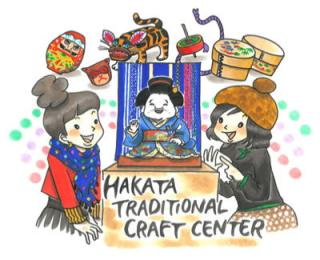Hakata Culture vol.57
Studying Hakata’s Traditional Crafts

Many traditional crafts that utilize manual dexterity still survive in Hakata. One facility where all of these crafts can be seen is the Hakata Traditional Craft Center. It is located near the Kusuda Shinto shrine, where Hakata’s guardian deity is enshrined. The center offers leaflets and videos in Japanese, English, Chinese, and Korean, as well as a café for relaxation during your visit.
The two largest exhibits at the center are of the Hakata-ori textiles and the Hakata ningyo, or dolls. The original techniques for Hakata-ori were brought from China about 770 years ago, but improvements have been added since then. It is particularly valued for making kimono belts, or obi. The silk material is very sturdy and retains its shape well. The technique is also used for dresses and handbags.
The Hakata ningyo date from the 17th century when the Fukuoka Castle was built. Their origin is said to be in the unglazed dolls created by the craftsman who were summoned to work on the castle. They are made in several forms, including women, children, and samurai, and their bright colors and smooth ceramic surface make them very attractive. They were often exhibited overseas during the Meiji period, including at the Paris Exposition, and became well known as representative of traditional Japanese crafts.
Eight different traditional crafts are on display at the center, including Hakata spinning tops, Hakata hariko (papier-mâché), and Hakata magemono (wooden objects). Young craftsmen also often come to study because there are many items and exhibits that can’t be seen anywhere else, including the works of renowned craftsman of the past and valuable historical materials.
Nearby is the Hakatamachiya Furusatokan, where craftsmen present demonstrations of Hakata-ori every day. There are also presentations on alternating days of craftsmen making Hakata tops, Hakata hariko, and Hakata magemono. Why not visit both for twice the fun?
博多の伝統工芸を学ぶひととき
博多には手仕事の良さを生かした伝統工芸が数多く残っています。そうした伝統工芸をひとつの施設で見学できるのが「はかた伝統工芸館」です。場所は博多の守り神として知られる櫛田神社のすぐ近く。リーフレットや案内ビデオは日本語・英語・中国語・韓国語の4カ国語が用意され、入場は無料。カフェも併設しているので気軽に訪れることができます。
館内で大きく展示されているのは博多織と博多人形の2つ。博多織は約770年前、中国から伝わった織物の技法がルーツとされます。その後は時代とともに改良が加えられ、現在では着物の帯として高い評価を得ています。絹を使ったしっかりとした生地は型くずれしにくく、ドレスやバッグなどの商品にも加工されています。
博多人形は17世紀に福岡城が築かれたころ、各地から集められた職人が作った素焼き人形がもとになったと言われています。スベスベとした陶器の肌ざわりと鮮やかな色彩が魅力で、女性や武士、子どもをテーマにしたものなどモチーフも多彩です。明治期にはパリ万博などに出品され、日本を代表する人形として知られるようになりました。
このほか博多独楽、博多張子、博多曲物など合わせて8種類の伝統工芸について展示しています。名人と呼ばれた職人たちの作品や、古い時代の貴重な資料など、なかなか見ることができない展示物も多いため伝統工芸を学ぶ若い職人たちも見学に来るそうです。
近くには「博多町家」ふるさと館があり、こちらでは博多織の手織り職人による実演を毎日行なっています。また日替わりで博多人形・博多張子・博多独楽・博多曲物などを作る様子が実際に見られます。ぜひ伝統工芸館と一緒に訪れてください。

